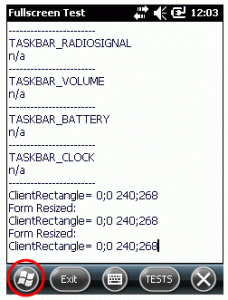Archive for the ‘Programming’ Category.
May 13, 2013, 16:36
The event db (it is my naming) holds all events and actions that can be invoked to launch an app or fire some events.
NotificationList
The tool shows all known notifications on a WM device. You can browse the event db and examine the defined events. Additionally the tool shows power change notifications.



In the mid window above you can see there is a timed event that will occur at 0:00 and start \windows\calupd.exe. This will wake your device all night and update the calendar entries for re-occurring schedules etc.
The right window shows the power notifications on a suspend/resume cycle.
Using the options menu you can save a list of the defined notification events.
Continue reading ‘Mobile Development: manage the event db, what wakes up your device’ »
April 19, 2013, 21:30
Screen layout changes from Windows Mobile 6.1 to Windows Mobile Embedded Handheld 6.5
The Windows Mobile screen geometry changed from Windows Mobile 6.1 and before to the actual Windows Mobile 6.5 (also called Windows Embedded Handheld). Not only the geometry changed, the layout also changed. The Start icon is now moved to the bottom whereas before WM65 the start icon was on the left in the taskbar.


The taskbar and the menubar was about 26 pixels in height. With WM65 the taskbar is about 18 pixels in height and the menu bar occupies 34 pixels in height.
| QVGA screen geometry |
Windows Mobile 6.1
|
Windows Mobile 6.5
|
| taskbar |
26
|
18
|
| menubar |
26
|
34
|
| client size |
240;268
|
240;268
|
| client size height no taskbar |
240;294
|
240;302
|
| client size height no menubar |
240;294
|
240;286
|
You can see that assuming a fixed client size will give problems with the layout of the application, especially if menubar and taskbar height are assumed as being 26 pixels all the time.
Applications that only use the client size with the taskbar and menubar visible, will show normally, as the resulting client size does not differ between WM61 and WM65.
Tags:
autoscale mode,
Compact Framework,
form factor,
fullscreen,
QVGA,
screen,
VGA,
windows mobile,
Windows Mobile 6 Category:
CodeProject,
Programming,
Tips |
Comments Off on Windows Mobile 6.5: Changed Screen Geometry
March 11, 2013, 21:14
With the latest update of download monitor plugin for wordpress I got a problem. The download code was not any more inserted into the post.
I place the cursor in my new post and the clicked the download monitor symbol (the arrow down) to upload and insert a new file. After entering a title and selecting the file to upload using the browse button to upload a local file, I click [Save Download].

Then at the bottom of the “Add Download” click on Save new download.

A new dialog pops up and I click [Insert into post]

Now nothing happens, the dialog remains on screen.
Continue reading ‘WordPress: Download Monitor upload/insert into post broken’ »
March 7, 2013, 16:09
Hello
attached is a small tool to alter foreign windows. You can show/hide, enable/disable and resize windows.
One example is to disable the taskbar window: showFullScreen -disable -class “HHTASKBAR”
How to launch
Here is a list of possible arguments:
Arguments: default meaning
-class "" class name of window to change, optional
-title "" title of window to change, optional
at least -class or -title must be used to change a window
-fullscreen false make window fullscreen
-maximized false make window normal size
-show no change make window visible
-hide no change make window invisible
-enable no change enable window
-disable no change disable window
-list - list windows into file
Examples
And here some more examples for usage:
Enable IE6 soft menu button: -class "IE6on6SoftKeyBar" -enable
Disable IE6 soft menu button: -class "IE6on6SoftKeyBar" -disable
Enable taskbar: -class "HHTASKBAR" -enable
Disable taskbar: -class "HHTASKBAR" -disable
make win fullscreen: -class "WFIcaClient" -fullscreen
List windows (like remote spy does)
Please use -list argument, to get a list of running windows:
Continue reading ‘Mobile Development: showFullScreen, a tool to change foreign windows attributes’ »












 http://www.led-mg.de
http://www.led-mg.de